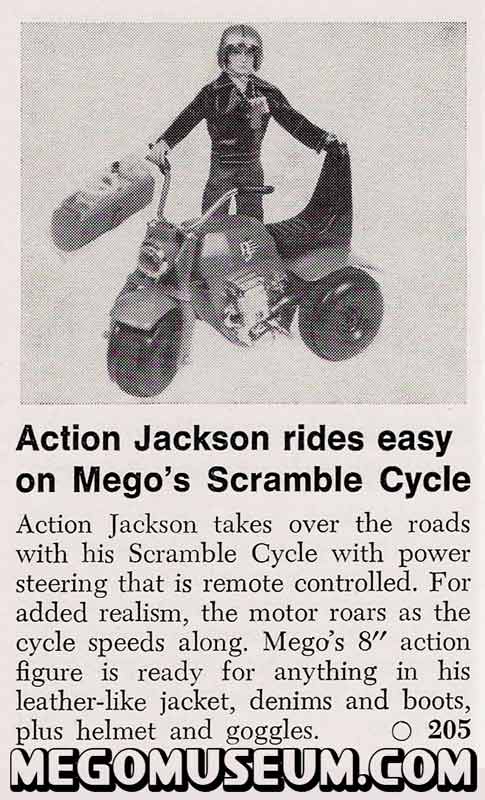 (February 1974) NEW YORK-A switch to a "concentration" television advertising strategy scored gains for Mego Corp. and its customers in 1973. The change involved Mego's spending less for TV than the year before, but-achieving greater in-depth impact in selected key markets. As a result Mego returned to the black, three of its products appeared on the Toy Hit Parade during the year, and its customers are said to have had a highly successful year with the line. The concentration strategy was developed with the aid of Ed Libov Associates, New York, a full service broadcast advertising agency that specializes in spot TV for consumer products and retail chains. It involved cutting the number of markets on Mego's media schedule from 69 to the 23 that account for the "lion's share" of sales; shortening the campaign from 24 weeks to 16, and positioning each spot on the schedule in order to better reach the key target audience.
(February 1974) NEW YORK-A switch to a "concentration" television advertising strategy scored gains for Mego Corp. and its customers in 1973. The change involved Mego's spending less for TV than the year before, but-achieving greater in-depth impact in selected key markets. As a result Mego returned to the black, three of its products appeared on the Toy Hit Parade during the year, and its customers are said to have had a highly successful year with the line. The concentration strategy was developed with the aid of Ed Libov Associates, New York, a full service broadcast advertising agency that specializes in spot TV for consumer products and retail chains. It involved cutting the number of markets on Mego's media schedule from 69 to the 23 that account for the "lion's share" of sales; shortening the campaign from 24 weeks to 16, and positioning each spot on the schedule in order to better reach the key target audience. 'You Can Control Position'
"There's a myth among spot TV advertisers that you can't control position if you get a bargain on the air time," says Libov. "The fact is, you can. And if your resources are limited, you must."
The key to positioning the Mego spots, he says, was to combine "early fringe" and "prime-access" time with children's A.M. time, heavily weighted toward "early fringe," when most school-age children are watching.
The target audience for Mego mer chandise, Libov notes, is the "plus five to nine-year-old, who's in school during most of the children's time. 'Early fringe' and 'prime-access' may appear to cost more, but the impression on the target audience actually is more effective. "
The schedule also used network TV time to reach those markets not covered by spots.
Sales-to-Ad Ratio Doubles The new approach led to increases in Mego's sales and profits, and its sales-to-advertising ratio nearly doubled, according to Neil B. Saul, vice president of marketing. Three Mego products, Dinah Mite, Lainie and World's Greatest Super Heroes, became best sellers.
Until 1971 Mego had largely been known as a supplier of imported toys and dolls in the 88 cents class, and its promotional strategy had been built around that fact. That year the company introduced Action Jackson, an action doll in the $2 to $3 class, and backed it-with a $2 million "shotgun" TV campaign. The following year Mego added many Action Jackson tie-in items, and planned to repeat the same kind of TV approach.
"We tried too many things at once," Saul concedes. "Too drastic a change in company identity, too many new products at once, and too much of the wrong kind of TV." Bearing him out was the company's track record for the year-a loss, a poor sales-to-advertising ratio and spotty retailer success.
Late in 1972, with Ed Libov's aid, Mego adopted a new strategy of extreme selectivity in marketing and new product introductions and concentration in its advertising. While the planning was begun in '72, it bore fruit in 1973.
"We began with the conclusion that Mego is Mego and not Mattel," Saul states. "The line, however good, was small, distribution was limited, and obviously so were the funds available for advertising."
"Rather than try to outgun the big names in the TV toy business," he continues, "we instead settled on the more modest, but more realistic, goal of supporting the customers we had with TV advertising, and making sure the line was profitable for us and our retailers. "
"We'll be advertising more in '74," Saul says, "but we'll retain the concentration strategy and possibly refine it still further.
Neal Saul left Mego for Azrak-Hamway/Remco in 1975. For more vintage mego articles please visit the MegoMuseum Ad Archive.
Labels: Action Jackson, Ad Archive, Mego, mego corp, neal saul
































